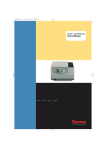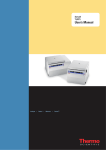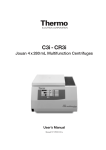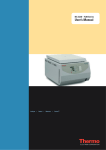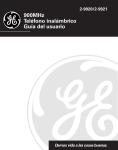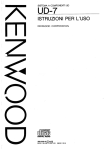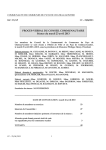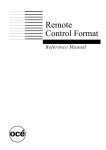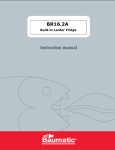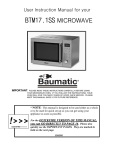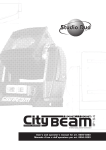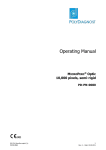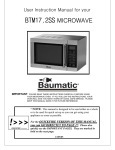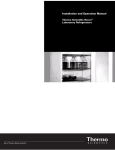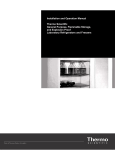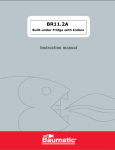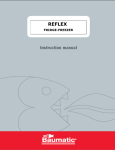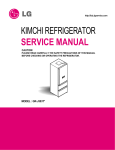Download Espresso ING
Transcript
Espresso User’s Manual Analyze • Detect • Measure • ControlTM Espresso User’s Manual Espresso Carefully read this manual before operating your instrument. Information contained in this document is the property of Thermo Electron Corporation; it may not be duplicated or distribuited without the owner’s authorization. The validity of the guarantee is subject to the observation of the instructions and precautions described in this document. Preface MANUAL NUMBER REV ECR/ECN DATE DESCRIPTION a 89003150 01/05 Initial release a2 89003150 02/06 Thermo Electron Corporation BY Espresso i Packing List 11210799 Centrifuge Espresso Item number 100V 50/60 Hz Quantity Check Centrifuge Espresso - 100V 50/60 Hz 1 11210802 Rotor 12x1,5/2,2 mL 1 11210803 Rotor lid 1 85440340 Rotor unit 1 89003150 User manual 1 11202744 Mains cable (120V) 1 - Lid opening tool 1 11210800 Centrifuge Espresso Item number 120V 60 Hz Quantity Check Centrifuge Espresso - 120V 60 Hz 1 11210802 Rotor 12x1,5/2,2 mL 1 11210803 Rotor lid 1 85440340 Rotor unit 1 89003150 User manual 1 11202744 Mains cable (120V) 1 - Lid opening tool 1 11210801 Centrifuge Espresso Item number 230V 50/60 Hz Quantity Check Centrifuge Espresso - 230V 50/60 Hz 1 11210802 Rotor 12x1,5/2,2 mL 1 11210803 Rotor lid 1 85440340 Rotor unit 1 89003150 User manual 1 11202744 Mains cable (230V) 1 - Lid opening tool 1 For missing parts call your nearest Thermo representative ii Espresso Thermo Electron Corporation WEEE Compliance Great Britain WEEE Compliance. This products is required to comply with the European Union’s Waste Electrical & Electronic Equipment (WEEE) Directive 2002/96EC. It is marked with the following symbol. Thermo Electron has contracted with one or more recycling/disposal companies in each EU Member State, and this products should be disposed of or recycling through them. Further information on Thermo Electron’s compliance with these Directives, the recyclers in your country, and information on Thermo Electron products which may assist the detection of substances subject to the RoHS Directive are available at www.thermo.com/WEEERoHS Deutschland WEEE Konformittät. Dieses Produkt muss die EU Waste Electrical & Electronic Equipment (WEEE) Richtlinie 2002/96ECerfüllen. Das Produkt ist durch folgendes Symbol gekennzeichnet. Thermo Electron hat Vereinbarungen getroffen mit Verwertungs-/Entsorgungsanlagen in allen EU-Mitgliederstaaten und dieses Produkt muss durch diese Firmen widerverwetet oder entsorgt werden. Mehr Informationen über die Einhaltung dieser Anweisungen durch Thermo Electron, die Verwerter und Hinweise die Ihnen nützlich sein können, die Thermo Electron Produkte zu identizfizieren, die unter diese RoHS Anweisung fallen, finden Sie unter www.thermo.com/WEEERoHS Italia Conformità WEEE. Questo prodotto deve rispondere alla direttiva dell’Unione Europea 2002/96EC in merito ai Rifiuti degli Apparecchi Elettrici ed Elettronici (WEEE). È marcato col seguente simbolo. Thermo Electron ha stipulato contratti con una o diverse società di riciclaggio/smaltimento in ognuno degli Stati Membri Europei. Questo prodotto verrà smaltito o riciclato tramite queste medesime. Ulteriori informazioni sulla conformità di Thermo Electron con queste Direttive, l’elenco delle ditte di riciclaggio nel Vostro paese e informazioni sui prodotti Thermo che possono essere utili alla rilevazione di sostanze soggette alla Direttiva RoHS sono disponibili sul sito www.thermo.com/WEEERoHS Espana WEEE Conformidad. Este producto requiere cumplir con la Directiva 2002/96EC WEEE (residuos de quipos electricos y electronicos). Este producto esta marcado con el simbolo WEEE, como se describe. En cada Estado Miembro de la Union Europea (EU), Thermo Electron ha contratado con diversas companias para disponer y/o re-ciclar los residuos de equipos electricos y electronicos. Existe information adictional acerca de la conformidad de Thermo Electron con esta Directiva, incluyendo los nombres de las diversas companias autorizadas para disponer/recyclar nuestros productos. Adicionalmente suministramos infor- Thermo Electron Corporation Espresso iii CEEE Compliance macion acerca de los productos de Thermo Electron que puedes asistir en la deteccion de substancian mensionades en la directiva RoHS, explicado en www.thermo.com/WEEERoHS France iv Espresso Conformité WEEE. Ce produit doit être conforme à la directive européenne (2002/96EC) des Déchets d’Equipements Electriques et Electroniques (DEEE). Il est marqué par le symbole suivant. Thermo Electron s’est associé avec une ou plusieurs compagnies de recyclage dans chaque état membre de l’union européenne et ce produit devrait être collecté ou recyclé par celles-ci. Davantage d’informations sur la conformité de Thermo Electron à ces directives, les recycleurs dans votre pays et les informations sur les produits Thermo Electron qui peuvent aider la détection des substances sujettes à la directive RoHS sont disponibles sur www.thermo.com/WEEERoHS Thermo Electron Corporation Declaration of compliance Declaration of compliance We, Thermo Electron Industries S.A.S., Z.I. d’Aze Bellitourne 53200 CHATEAU-GONTIER, France, declare that the instrument defined here below complies with the following European directives: Declaration de conformite Nous, Thermo Electron Industries S.A.S., Z.I. d’Aze Bellitourne 53200 CHATEAU-GONTIER, France, déclarons que le matériel désigné ciaprès est conforme aux directives européennes suivantes: Konformitätserklärung Wir, Thermo Electron Industries S.A.S. , Z.I. d'Aze Bellitourne 53200, CHATEAU-GONTIER, France, erklären dass das hier beschriebene Gerät sich in Übereinstimmung mit folgenden europäischen Richtlinien befindet: Declaración de conformidad Nostros, Thermo Electron Industries S.A.S., Z.I. d’Aze Bellitourne 53200 CHATEAU-GONTIER, France, declaramos que el instrumento bajo descrito está fabricado según las especificaciones establecidas por las siguientes normas europeas: Declaraçao de conformidade Nós, Thermo Electron Industries S.A.S., Z.I. d’Aze Bellitourne 53200 CHATEAU-GONTIER, France, declaramos que o instrumento aqui apresentado está de acordo com as normas européias abaixo listadas: Dichiarazione di conformità Noi, Thermo Electron Industries S.A.S., Z.I. d’Aze Bellitourne 53200 CHATEAU-GONTIER, France, dichiariamo che lo strumento sotto descritto è conforme alle seguenti Direttive europee: Thermo Electron Corporation • Machinery: 98 / 37 / CEE • Low voltage: 72 / 23 / CEE - 93 / 68 CEE • EMC: 89 / 336 CEE - 92 / 31 CEE - 93 / 68 CEE • Safety standard: EN 61010-1 - EN 61010-2-020 Espresso v Guarantee Terms Thermo guarantees that this unit is free from defects in materials and workmanship when it leaves the factory, and will replace or repair the unit if it proves defective in normal use or during service for a period of ONE YEAR from the delivery. This guarantee is invalid if the unit is incorrectly used, poorly serviced or neglected, mis-used or accidentally damaged. There is no explicit guarantee other than as stated above. vi Espresso Thermo Electron Corporation For further information, assistance or service United States of America Tel.: +1 866 213 17 90 Fax: +1 866 984 37 66 Canada or Latin America Tel.: +1 866 213 17 90 Fax: +1 866 984 37 66 China (Shanghai) Tel.: +86 21 68 65 45 88 Fax: +86 21 6445 7907, +86 21 6445 7830 India (Mumbai) Tel.: +91 22 5542 9494 Fax: +91 22 5542 9495 Japan Tel.: +81 454 53 9220 Fax:+ 81 454 53 9222 Other Asia-Pacific Countries Tel.: +852 28 85 46 13 Austria Tel.: +43 (1) 80 14 00 France Tel.: +33 1 69 18 77 77 +33 2 28 03 20 00 Belgium Tel.: +32 24 82 30 30 Italy Tel.: +39 02 95 05 91 Netherlands Tel.: +31 7 65 71 44 40 Russia/Cis Tel.: +7 09 52 25 11 15 Spain and Portugal Tel.: +34 9 32 23 31 54 Switzerland Tel.: +41 (1) 4 54 12 12 United Kingdom and Ireland Tel.: +44 87 06 09 92 03 Other Europe, Middle East, or Africa Tel.: +49 61 8490 6940 Tel.: +33 2 2803 2000 In Other Countries: Contact your local THERMO products distributor or agent. E-mail Technical Service Representative for products at: [email protected] Visit our web site at: www.thermo.com Germany Tel.: +49 61 84 90 69 40 Fax: +49 61 03 40 81 012 Finland Tel.: +35 89 32 91 00 Thermo Electron Corporation Espresso vii Contents viii Espresso Chapter 1 Use and Function........................................................................................1-1 User Manual......................................................................................1-1 Warning Symbols ..............................................................................1-1 Description ......................................................................................1-1 Refrigeration and Heating Systems....................................................1-2 Drive System ....................................................................................1-2 Safety Interllock System ....................................................................1-2 Centrifugation Formulae ..................................................................1-3 Chapter 2 Specifications............................................................................................ 2-1 Dimensions and Weight ....................................................................2-1 Centrifugation Specifications ............................................................2-1 Electrical Specifications ....................................................................2-2 Chapter 3 Installation.................................................................................................. 3-1 Environmental Conditions ................................................................3-1 Unpacking and Positioning ..............................................................3-1 Mains Supply ....................................................................................3-2 Lid Opening and Rotor Checking ....................................................3-2 Manual Lid Unlocking Procedure ....................................................3-3 Chapter 4 Instructions for Use....................................................................................4-1 Controls and Indicators ....................................................................4-1 How to Prepare for the First Run......................................................4-2 Sample Loading ................................................................................4-2 Operating the Unit............................................................................4-3 End of the Run ................................................................................4-4 Chapter 5 Messages ....................................................................................................5-1 Information Messages........................................................................5-1 Error Messages ..................................................................................5-1 Allarm Messages ................................................................................5-2 Chapter 6 Hazard, Precautions and Limitations of Use ........................................6-1 IEC 1010-2-020................................................................................6-1 Cautions............................................................................................6-1 Rotor maintenance ............................................................................6-2 Cleaning............................................................................................6-2 Contamination Hazards ....................................................................6-2 Thermo Electron Corporation Contents Disinfection ......................................................................................6-3 Radioactive Decontamination ..........................................................6-3 Chemical Compatibility ....................................................................6-4 Limitations......................................................................................6-10 Aerosol Risks ..................................................................................6-10 Chapter 7 Thermo Electron Corporation Maintenance ..............................................................................................7-1 Periodic Cleaning ..............................................................................7-1 Fuse Replacement..............................................................................7-1 Power Supply Ciscuit Breacker ..........................................................7-1 Espresso ix Chapter 1 User Manual Use and Function The user manual is part of the centrifuge, and contains important information for your safety and for the best use of the equipment. Always keep the manual close to the appliance and in a safe place, so that it is always available. Thermo strongly recommends that all users read this manual carefully. Warning Symbols The following symbols are provided to help the operator take advantage of the protection afforded by the equipment and to warn of potential danger. The following symbols are provided for the operator to know how to take advantage of the protection afforded by the equipment and to avoid dangers. On the main switch, allows centrifuge to operate if pressed. L Only authorized personnel may handle the parts marked with this symbol nd only after switching off the mains supply. Working with high voltages could cause severe injuries. L In the following manual, this symbol means that you will find important information for safety. If these announcements are not observed the user risks damaging the appliance and/or harming an operator. L In the following manual, this symbol means that you will find important information concerning biological risk: if these announcements are not observed the user and bystanders risk exposure to biohazards. L Description Thermo Electron Corporation The Thermo Espresso centrifuge is designed for laboratory use. Through the application of Relative Centrifugal Force (RCF), it allows the separation of substances made of different density elements. A control system permits the user, through an extremely intuitive control panel, to set and control the speed, g-force and run time, as well as to receive different messages and warnings. The Thermo Espresso rotors are compatible with microtubes with capacity from 0.2 mL to 2 mL.The Thermo Espresso is a ventilated Espresso 1-1 Chapter 1 Use and Function Refrigeration and Heating Systems Drive System Safety Interlock System unit. A permanent air circulation reduces the heat level in the bowl. However the temperature in the bowl can exceed 10 °C above the ambient temperature after hours of continuous operation. A brushless motor drives the rotating equipment. During the run, the rotor is contained in an armor plated centrifugation chamber. The brushless motor requires no maintenance. A control system ensures the correct drive speed, which is continuously monitored. The Thermo Espresso centrifuge is equipped with a motorized interlock system that assures two basic safety features: • The run cannot be started if the lid is not correctly closed. • The centrifuge lid cannot be opened if the rotor is running. During the run, the lid remains latched until the rotor stops spinning. As soon as the run end and the rotor is fully stopped, the lid latch is automatically disengaged and the lid may be easily opened. If a power failure occurs, access to the samples in the centrifuge is possible via a manual lid opening procedure (see appropriate paragraph). For this operation a special tool (supplied with the centrifuge) is required. Bypass the interlock system only under emergency conditions as the rotor could still be rotating. L 1-2 Espresso Thermo Electron Corporation Chapter 1 Use and Function Relative Centrifugal Force Relative Centrifugal Force (RCF), at the circumference of the rotor is directly proportional to the speed (rpm) and radius of the rotor. Therefore, a greater rpm and/or a larger radius produces a greater RCF and improved faster separation of substances. The centrifuge control system carries out and displays the results of all calculations related to speed and RCF. Configuration formule Legend R = radius (in millimetres) N = speed (in r.p.m.) ÷ 1000 RCF = gravitational acceleration ‘g’ M+ = add to memory MR = memory recall Note To calculate actual results, press the keys on a pocket calculator in the order shown. L Primary calculations RCF (x g) Key sequence (not valid for CASIO, HP) = 1.118 R N 2 Speed (r.p.m.) = 946 RCF N x = x 1.118 x R = RCF ÷ R = √ x 946 = R Radius (mm) = RCF 1.118 N N x = x 1.118 = M+ RCF ÷ MR = 2 Transformations Key sequence To determine actual ‘g’ achieved at a different speed: ( ) N2 RCF2 = RCF1 2 N2 ÷ N1 = x = x RCF1 = N1 To determine actual speed required to achieve a different ‘g’ at the same radius: N2 = N1 RCF2 RCF2 ÷ RCF1 = √ x N1 = RCF1 To determine actual speed required to achieve the same ‘g’ at a different radius: N2 = N1 R1 R1 ÷ R2 = √ x N1 = R2 Thermo Electron Corporation Espresso 1-3 Chapter 2 Dimensions and Weight Specifications Centrifuge Height 15 cm 5.90 in Width 25 cm 9.84 in Depth 20 cm 7.87 in Net Weight 4.2 Kg 9.26 lbs. Height 20 cm 7.87 in Width 28 cm 11,02 in Depth 28 cm 11,02 in Net Weight 5.5 Kg 12.13 lbs. Package Configuration Specifications Espresso Max. speed: 14600 rpm Max. RCF at tip: 14500 x g Max. Capacity: 12 x 2 mL Max. allowable density: 1200 Kg/ m3 Max. allowable weight: 28.8 g (0.048 kg including tubes) Work temperature: Tamb + ΔT Max ΔT: 12 °C Max. noise: 56 dBA Microprocessor controlled Speed set: 5000 to 14600 rpm, step 100 rpm Speed display accuracy: 100 rpm RCF set: 1700 to 14500 xg, step 100 x g RCF display accuracy: 100 xg Timer set: 15 seconds to 99 min + “Hold” (continuos mode) Timer set step: 15 seconds (up to 1 minute) 1 minute (between 1 and 99 minutes) Timer step (both count-up and count-down mode) 1 minute between 99 minutes and 1 minute. 1 second between 1 minute and 0. 2-1 Espresso Thermo Electron Corporation Chapter 2 Specifications Electrical Specifications Espresso Nominal operating voltage: 230V ± 10% 50/60 Hz 120V ± 10% 60 Hz 100V ± 10% 50/60 Hz Max peak current (during acceleration): 1,5 Arms (at 230V) 2,5 Arms (at 120V) 2,9 Arms (at 100V) Thermo Electron Corporation Max power (steady state): 60 W Heat output (steady state): 208 Btu/h Espresso 2-2 Chapter 3 Environmental Conditions Installation General conditions accepted for centrifuge transport and storage are: • Ambient temperature -20°C to +50°C. • Relative humidity up to 90%. General conditions accepted for operating the centrifuge safely are: Unpacking • Indoor use. • Temperature: 5 °C to 40 °C. • Maximum relative humidity of 85%. • Maximum altitude: 2000 m • Installation category: II • Polution degree: 2 All lifting and transporting must be carried out by using proper handling equipment and by people having undergone the necessary training. Thermo strongly recommends that all operators comply with the local laws and regulations on safety and health in the workplace. • Unpack the centrifuge, carefully removing any possible accessory you might find in the package • Check the contents of packaging using the packing list provided above. • Keep the packaging until the centrifuge has been tested. The machine must be installed in a dust and corrosion free room. Place the centrifuge on a bench top, which must be rigid, horizontal and sufficiently strong to support the centrifuge weight and any possible small vibrations. Leave a 30 cm / 11.81 in space free on each side of and behind the machine for safety reasons and for correct ventilation. L 3-1 Espresso Thermo Electron Corporation Chapter 3 Installation Mains Supply Check mains and frequency: they must correspond to the values shown on the instrument identification label. Cat number Content Voltage Frequency Type 11210799 Espresso – 100V 100V ± 10% 50/60 Hz 1 phase + ground 11210800 Espresso – 120V 120V ± 10% 60 Hz 1 phase + ground 11210801 Espresso – 230V 230V ± 10% 50/60 Hz 1 phase + ground For your safety, check that mains wires are effectively grounded. Thermo declines all responsibility for any damages due to nongrounding of the machine. In order to fully disconnect the equipment from the power supply, it is mandatory to physically disconnect the mains cable. The switch cuts the product functionality only. L Remember that in order to respect the electrical safety standards related to protection against indirect contact, the supply of power to the instrument must be via a power socket fitted with a protection device ensuring automatic cut-off in the case of an insulation fault. A supply fitted with a circuit breaker of the correct rating complies with this requirement. Lid Opening and Rotor Checking • Connect the mains lead to the back of the unit and to a power socket • Switch the centrifuge by pressing “I” on the main switch located on the back side of the unit. • The software version will appear during the initial self test • A led test will be performed Press the LID OPEN key, and lift the centrifuge lid.The Thermo Espresso is delivered with the rotor inside. 1,2 3,4 Thermo Electron Corporation Espresso 3-2 Chapter 3 Installation To remove the rotor To install the rotor Manual Lid Unlocking Procedure • Remove the lid • Unscrew the rotor locking nut from the engine shaft counterclockwise (no tool is required!) • Remove the rotor from the shaft • Check that the motor shaft and rotor are clean • Put the rotor on the motor shaft ensuring the correct alignment between the shaft pins (a) and the rotor arrows (b) • Secure the rotor on the shaft by turning the nut clockwise • Verify that the rotor cannot be removed by trying to pull it (gently) off the shaft. In the event of mains non-availability or power failure, opening of the lid is prevented by the lid locking safety device. It is recommended to wait for the mains to be switched back on so that this safety device enables the lid to be unlocked. Rotating parts are a risk as they could come in contact with the user or be ejected. There is particularly high risk of injury if: • The user attempts to manually stop the rotor • Any object falls inside the centrifugation chamber while the rotor is running. L Manual lid unlocking may be necessary under a very limited number of conditions, such as the urgent recovery of critical samples that could be damaged if left in the centrifuge rotor. In this case the lid can be opened by using the special tool supplied with the centrifuge. 3-3 Espresso Thermo Electron Corporation Chapter 3 Installation Always set the mains switch to the “O” position before performing this manual procedure, even in the case of a mains power outage. L Should the emergency occur due to electricity failure during centrifugation, wait at least 10 minutes for the rotating equipment to stop spinning. In spite of the absence of noise, the rotor may still be rotating when you begin to open the lid manually. • Insert the unlocking tool (or a flat screwdriver) horizontally into the hole on the right hand side of the instrument by piercing the protection sticker • By using the tools, turn the gear inward until the lid latch is disengaged. • Upon opening, lift the lid by hand and observe the rotor (be careful with this operation): if it is still rotating, close the lid and wait. The protection sticker must be replaced after it has been pierced (item 85241801) Percer ici avec l'outil ! Pierce here with tool 85 24 1 77 2 En cas de nécessité, pour le déverrouillage manuel du couvercle, attendre 10 min. ou l’arrêt du rotor avant d’utiliser l’outil spécifique fourni à cet effet. Cette étiquette, après avoir été percée, doit être changée. If it is necessary to open the lid manually, wait 10 min. or until the rotor has stopped rotating, before using the lid opening tool provided. This label must be changed once it has been pierced. ! Thermo Electron Corporation Espresso 3-4 Chapter 4 Instructions for Use Controls and Indicators All the controls are located on the front panel (except for the mains switch which is at the back of the centrifuge). The Thermo Espresso front panel is an intuitive interface: no previous operational knowledge is necessary; every parameter can be set by rotating the knob continuously, from the minimum to the maximum and viceversa. All parameters can be accessed and changed both during operation and while the machine rest. Time display Time set key Speed/RCF display Speed/RCF toggle Speed/RCF led Rotation knob PULSE for quick runs START Stop Lid open Key Indicator Function Starts the centrifugation run. The run will start only if the lid is properly locked. Stops the centrifugation run. When the rotor is at full rest, the lid will open automatically. This key can also be used to open the lid once it has been closed, but the run is not started. Pulse key for very short runs. The motor accelerates to the set speed while the key is pressed and brakes when the key is released. Pressing this key allows time set using the knob. Digital display of run time: • Counts-up in PULSE and Hd (continuos) mode • Counts-down in time-set mode Pressing this key allows toggle between speed (RPM) and RCF (xg) and set of the corresponding parameter, using the knob. This function is available either during set or during the run. Digital Display of Speed = 5000 to 14600 rpm. Digital Display of RCF = 1800 to 14500 x g. A LED is illuminated to indicate the selected unit (rpm or RCF). 4-1 Espresso Thermo Electron Corporation Chapter 4 Instructions for Use How to Prepare to the First Run Before installation, the rotor should be thoroughly inspected for evidence of damage and for cleanliness. Chemical and stress corrosion of plastic parts will eventually lead to disruption of the rotor with potential severe damage to the centrifuge. Particles stuck inside the pockets can cause breakage of tubes and lead to major imbalance and / or loss of sample and contamination. The central hole of the rotor and the 2 drive spindles should also be clean and undamaged. These parts should be wiped clean on regular basis The centrifuge also should be observed: screw, lid hooks, latch and evidence of corrosion. In case of problems contact your Thermo Service representative, because any deviation from the above mentioned advice may have serious consequences for the safety of the appliance and of the operators. L Normal use of the centrifuge could require the manipulation of biohazards. The users and service personnel must have specific training for each substance they use, according to the “Laboratory Biosafety Manual” from the World Health Organization. L Sample Loading The contents of each rotor pocket including sample, tube, cap and adapter (where used) must be of the same weight as the one diametrically opposite. Imbalance of the rotor may cause major damage to the rotor and centrifuge. Do not attempt to introduce liquids into rotor pockets or into tubes already in the pockets. L Distribute the load correctly. Loads should be inserted two by two, of equal weight, at 180 degrees from the rotation axis and at equal distance (radius) from the center of rotation ( see picture) Correct Thermo Electron Corporation Incorrect Espresso 4-2 Chapter 4 Instructions for Use If less than the maximum complement of samples is loaded, the tubes must be placed in opposite pockets. An odd number of tubes requires an additional blank, water-filled tube of identical total weight to balance. Significant vibrations can damage the accessories, the unit and the samples. Most vibration is caused by incorrect loading of the tubes Operating the Unit After having placed, locked and loaded the rotor, lower the centrifuge lid. A motorized lid latch will secure the lid as soon as the start or pulse key are pressed. If one or more parameters need to be changed: • Select the time by pressing the TIME key and rotating the knob to the desired value. • Select the speed / RCF by pressing the speed / RCF key and rotate the knob to the desired value. Toggle between speed (RPM) and RCF (xg) by pressing the speed/RCF key. If the set parameters currently displayed are those desired, the instrument is ready to run. The presence of the operator is necessary • from the start until centrifuge reaches set speed. • at the end of the centrifugation run. L Press START or PULSE key. The START key runs the program, while - for very short runs continuously pressing on the PULSE key permits the rotor to accelerate to the maximum speed. If the lid is not closed properly, the display will indicate “Lid”. As soon as the lid is properly closed, the run parameters will be redisplayed and the run can be started. During a run, the RPM display shows the actual speed, while the time display will show: • remaining run time “count-down ” if the START key was pressed • elapsed run time in minutes “count-up ” if the PULSE key was pressed or Hd selected. To change set values during a run: • 4-3 Espresso press the TIME or speed / RCF key Thermo Electron Corporation Chapter 4 Instructions for Use • turn the knob to the desired value The display shows the set value for 2 seconds; during this time, it is possible to change set value. End of the run Deceleration will take place when the run time is completely elapsed, or the PULSE key is released, or the STOP key is pressed. At the end of the run the user is alerted to the fact that samples remain in the centrifuge. For this reason, the lid will open automatically at the end of the run. Note The centrifuge stop may also occur automatically for: • load imbalance • sudden power failure • error or components breakdown L See the “messages” section for details. Thermo Electron Corporation Espresso 4-4 Chapter 5 Information Messages Messages Information messages are an integral part of the routine operations: they are friendly and the meanings are easy to understand. LED message Signification Action SF Software release Wait few seconds X.X The centrifuge is powered on, and the initial self test is being performed. 00 You can open the centrifuge lid Press on LID OPEN key 00.0 Error Messages Error messages relate to improper operating procedures. LED message Signification Action Lid Lid is open when trying to start Close lid before pressing the START or PULSE key. If the message persists, call Thermo Service Er LJA Usr The lid opening system has been Check that the lid is free to open. activated but the lid could not open Try again by pressing the LID OPEN key You entered the diagnostic mode Do not press any key Switch the centrifuge off and restart 5-1 Espresso Thermo Electron Corporation Chapter 5 Messages Allarm Messages Alarm messages relate to dangerous operations or fault conditions L LED message Signification Action No display No main power connection Plug in the main power cable Power failure Check the main power fuses: if they are burned out, call Thermo Service for a diagnosis of any possible fault before replacing the fuses Lid The lid is closed but the message persists Call Thermo Service Er Lid Lid open during running (possible latch fault) Call Thermo Service Er OSP Over speed Call Thermo Service Er NoS Speed sensor failure Motor failure Call Thermo Service Drive failure Er HAL Speed sensor failure Call Thermo Service Er Shr Internal component damage Call Thermo Service Er Spd Internal component damage Call Thermo Service Er PFA Power failure during the run The rotor stops inertially Press STOP and restart Thermo Electron Corporation Espresso 5-2 Hazards, Precautions and Limitations of Use Chapter 6 IEC 1010-2-020 This centrifuge conforms to the IEC 1010-2-020 international standard, which specifies particular safety requirements for laboratory centrifuges. According to the standard warnings, the operator must respect the following precautions : Cautions • Mark a boundary area of 30 cm around the centrifuge. • No person or hazardous material can stay within this boundary longer than necessary for operational reasons, while the centrifuge is operating. • An emergency switch for disconnection of the mains, in case of malfunction, has to be available and familiar to all the persons operating the centrifuge. This switch has to be remote from the laboratory centrifuge, preferably outside the room in which the centrifuge is located, or adjacent to the exit from that room. • Moving or shifting the machine during centrifugation is dangerous. • Using the centrifuge with rotating equipment showing signs of corrosion and wear, and manipulating and/or tampering with the electronic and mechanical parts constitute dangerous operations. L • Never try to bypass the lid safety interlock while the rotor is spinning. • Do not try to open the lid until the display returns to the stand-by mode. • • Only use a correctly grounded mains source. Use only rotors and accessories designed for use in the Thermo Espresso centrifuge. Pay special attention to the following: • 6-1 Espresso Installation of the unit: proper ventilation, leveling of the centrifuge, rigidity and stability of the support. Thermo Electron Corporation Chapter 6 Hazards, Precautions and Limitations of Use • Rotor installation: verify that the rotor is locked in position before use. • Cleaning of the accessories and of the rotor chamber is particularly necessary when corrosive products are present in the samples (saline, acids, bases). • Load balancing. IF ANY DANGEROUS EVENT OCCURS, KEEP YOURSELF FAR AWAY FROM THE INSTRUMENT AND SWITCH OFF THE MAIN POWER SOURCE Rotor Maintenance Cleaning Contamination Hazards Ideally, rotors should be washed after every use and at least weekly in warm water containing a few drops of mild non alkaline detergent (domestic liquid soap is ideal) and every time a spill has occurred. Do not forget to wash the core of the rotor that comes into contact with the drive spindle. Each pocket of the rotor must be washed thoroughly using a small nylon brush. Do not use metal wire brushes. Once the rotor is clean, rinse it in running water, preferably distilled water. Dry the rotor with a soft absorbent non-woven cloth or tissue. Drying may be finished off with a warm air jet (e.g. a hair dryer). Make sure that the pockets are well dried. The Thermo Espresso is likely to be used in medical research where hazardous substances, including radioactive chemicals, are frequently found. ALWAYS USE THE APPROPRIATE DECONTAMINATION PROCEDURES WHERE THE ROTOR IS EXPOSED TO THESE CHEMICALS. L Examples of commonly used techniques are outlined below. The information is given as a guideline only. It is the responsibility of the owner to use the most suitable procedure. If decontamination procedures require the use of warming (i.e. autoclave) the rotating equipment should always be completely disassembled before being subjected to heat and after external chemical cleaning. Seals should be decontaminated with the method most suitable for them, which might not be the same as for the body of the rotating equipment. Thermo Electron Corporation Espresso 6-2 Chapter 6 Hazards, Precautions and Limitations of Use Disinfection Alcohol (70% ethanol or isopropanol) applied for 10 minutes is ideal for bacteria and viruses. Autoclave for 20 minutes at 120°C to destroy micro-organisms. The polypropylene rotors are autoclavable. Rotor lids must be disassembled from rotor bodies. ‘O’ rings, autoclaved separately, should be replaced when deformed. Any part which has been subjected to temperatures above 130 C° must be discarded Hypochlorite “bleach” used at 0.1% concentration with 10 minutes immersion is effective against bacteria, spores and viruses but, as an oxidizing agent, is corrosive to metal alloys and must be thoroughly rinsed off of metal parts and the parts dried. It should never be used if there is surface damage to the rotor. Formalin (37% formaldehyde in water) in contact for 10 minutes has a similar effect to chlorine bleaches. Rotors should be thoroughly rinsed under running water for 5 minutes to remove all traces of formalin then dried completely. Formaldehyde is toxic L Gluteraldehyde 2%, sold under many brand names such as Cidex and Glutarex, requires total immersion for 10 minutes to ensure sterility. Thorough rinsing and drying is essential to protect users. Gluteraldehyde builds up to a toxic level in the fatty tissues of the body. Phenols are very corrosive and should never be used. L Radioactive Decontamination We recommend that all radioactive contamination be referred to your Radioactivity Safety Officer. Rotors may be decontaminated by a mixture of equal volumes of : • Distilled water, • SDS diluted to 10%, • Ethanol diluted to 70%. The rotor should then be rinsed with ethanol followed by distilled water and then dried completely. Thermo makes no claims as to the effectiveness of proprietary brands of decontaminating solutions. 6-3 Espresso Thermo Electron Corporation Chapter 6 Hazards, Precautions and Limitations of Use Chemical Compatibility Table for Rotors, Tubes and Accessories S = Satisfactory D = Discoloration but OK P = Pure chemical OK M = Moderate resistance U = Unsatisfactory X = Explosion risk !!! O = No information d = Less resistance if T > 50°C t = Unsatisfactory if T >50°C Material Chemical Acetaldehyde Acetamide Acetic Acid (5%) Acetic Acid (20 %) Acetic Acid (60%) Acetic Acid (80 %) Acetic Acid (Glacial) Acetic Anhydride Acetone Acetonitrile Acetylene Adipic Acid Alanine Allyl Alcohol Aluminum Chloride Aluminum Fluoride Aluminum Hydroxide Aluminum Nitrate Aluminum Sulphate Amino Acids Ammonia Ammonium Acetate Ammonium Carbonate Ammonium Chloride Ammonium Hydroxide (10%) Ammonium Hydroxide (conc) Ammonium Oxalate Ammonium Phosphate Ammonium Sulphate Ammonium Sulphide n-Amyl Acetate Amyl Alcohol Amyl Chloride Aniline Thermo Electron Corporation AL CAB DL NO PA PE PPCO SS TZ VA = Aluminum = Cellulose acetate butyrate = Delrin = Noryl = Polyallomer (= PPCO) = Polyethylene = Polypropylene Copolymer = Stainless steel = Tefzel = Viton A AL BN CAB CN DL KY NO NY PA PC PPCO S U U U O O O O M U O O O O O O O O S U S M S S M S S S S S S O O O O O O O S M S U U U U S S M S U S O O O O O O O S U S U U U U S O O S U S O O O O O O O Sd U S U U U M M O U S U O O O O O O O O Mt U S O O O O O O O S O O O O O O O O O S S S O O O O O O O S S O O U O S O O U O S O O S S O S O S S S O O O O O S O S S U S O O O O O O O S Mt M O O O O O O O S O S O O O O O O O Sd O S O O O O O O O S S S O O O O O O O S U O O O O O O O O S S S U S S O S O S S U M O O O O O O O St O O S U O O O O S D U O U U O O O O S D U O O O O O O O O Sd S U O O O O O O O S M S S O O U O O S S S O O O O O S O O S U S O O O O O O O Sd U S M U O S O O S S S S O O O O O O O U U S O O O O S O O U O BN CN KY NY PC PP PS TF TI = = = = = = = = = Buna N Cellulose Nitrate Kynar Nylon Polycarbonate Polypropylene Polysulfone Teflon Titanium PE PP PS SS TF TZ TI VA M S S S M St M U S S S St U S S S Sd O S S S S S St S S S S S O Sd S U S M O S S D S S S D S S M D M Sd U M U Mt U S U S S S U S O S O S O S S S O Sd O S S S Sd S O S S St O D S D O Sd S S O S O S O Sd U S O U U M O S O S O S O S O S O O O O O U O O O O O O O S O S S O O S O O O O O S O S O S O S O S O O O O S S S O O O O O S S O S S O O S S O S O S M O S O S O S O M O O O O S S O O O O O O S S O S S O O S O O S O S S O S O S O S O S O O O O S S S O O O O O S S O S S O O S O O S O S Espresso U O M O U O U O U O O O O O O O O O O O O O O O S U O O O O O M O O 6-4 Chapter 6 Hazards, Precautions and Limitations of Use Material Chemical Aqua Regia Barium Chloride Barium Hydroxide Barium Sulphate Benzaldehyde Benzene Benzoic Acid, Sat Benzyl Acetate Benzyl Alcohol Boric Acid Bromine Bromobenzene Bromoform Butadiene Butane n-Butanol n-Butyl Acetate Butylene Butyl Chloride Butyric Acid Caesium Acetate Caesium Bromide Caesium Chloride Caesium Formiate Caesium Iodide Caesium Sulphate Caesium Trifluoracetate Calcium Carbonate Calcium Chloride Calcium Hypochlorite Calcium Sulphate Carbazole Carbon Sulphide Carbon Tetrachloride Cedarwood Essence Chlorine, dry Chlorine, moist Chloroacetic Acid p-Chloroacetophenone Chlorobenzene Chloroform Chlorosulphonic Chromic Acid (5 %) Chromic Acid (10%) Chromic Acid (50%) Cinnamon Essence Citric Acid (10%) Copper Nitrate 6-5 Espresso AL BN CAB CN DL KY NO NY PA PC PPCO U U U O U O O O U U U O O O O O O O S O U O O O O O O O S O S O O O O O O O S O S O O O O O O O Sd Mt S U P O M O O S U U St O O O O O O O Sd Sd O O O O O O O O Sd Mt S U U O M O O U U U U O O O O O O O S U U O O O O O O O U Mt U O O O O O O O U U U O O O O O O O U U S O O O O O O O U U S O O O O O O O O O S S U O S O O U O M S O O O O O O O S U S O O O O O O O O O O O O O O O O O U U S O O O O O O O U Mt M O O O O O O O S S M O O O O O O O S S M O S S O O O O S S M O O O O O O O S S M O O O O O O O S S M O O O O O O O S S M O M U O O O O S S U O O O O O O O S O M S S O S O O S S M M U O O M S O S S M M O O O O O O O S O O O O O O O O O S U S O O O O O O O U U X U S S M S O S U U O O O O O O O O U St M O O O O O O O St Sd U O O O O O O O Mt Sd U O O O O O O O Sd Mt O O O O O O O O S U O O U U O S O O U U X U M S M S O U U U M O O O O O O O M O U O O O O O O O S M M U U U U S S O S M U U U S U S O O D U O O O O O O O O U St S S S O M S S M S S U O O O O O O O S O PE PP PS SS TF TZ TI VA U S S St S U S S U Sd U U U U O S S S U U S S S S S S S St O S St S U U U St St S S U U M S S S U S S U S S S Sd U Sd Sd U S U U U U O S S O U U S S S S S S S S D S S S U U U St Mt Sd S U U M S S S U S S O O O O M U M U O U U U U U O M U O U S S S S S S S S O S S O U U S M O O U U O U O U U U M S O O O O O O S O O O O O O O O O O O O O O O O S O O O M O S U O O O M O O O O O O S O O U U O S O S O O O O S O O S O O O O O O S O O O O S S S S S S S O S S O O O S O O O O O S S O O S S O S O S S O O O O O O O O S S O O O O S S O O O O O O O O O O O O S S O O O O O O O O S O S O S S S O S O S O O O O O O S O S O O O O O O S S O O O O O O O O O O O S M S O O O O S S S M O O S S O O M O O O O S O O S O O O O O O S O O O O O O O O O O O O S S O O O S O O O O O O S O O S S O S O Thermo Electron Corporation Chapter 6 Hazards, Precautions and Limitations of Use Material Chemical Copper Sulphate Croesol Cyclohexane Cyclohexanol Cyclohexanone Cyclopentane Decane Dextran Sulphate Diacetone Diacetone Alcohol o-Dichlorobenzene p-Dichlorobenzene Dichloroethane Dichlorophenol Diethylamine Diethyl Benzene Diethylene Glycol Diethylene Glycol Ethyl Ether Diethyl Ether Diethyl Ketone Dimethylacetamide Dimethylformamide Dimethylsulphoxide Dioxane Diphenyloxide Dipropylene Glycol Distilled Water Ethanol (50%) Ethanol (95%) Ethyl Acetate Ethyl Benzene Ethyl Benzoate Ethyl Butyrate Ethyl Chloride Ethylene Chloride Ethylene Glycol Ethylene Oxide Ethyl Ether Ethyl Lactate Ethyl Malonate Fatty Acids Ferric Chloride Ferric Nitrate Ferric Sulphate Ficoll Paque Fluorine Fluorhydric Acid (10%) Fluorhydric Acid (50%) Thermo Electron Corporation AL BN CAB CN DL KY NO NY PA PC PPCO U O O O O O O O S O S O O O O S O U S U S O O O O O O O Mt Sd S O U O O O O S S M O O O O O O O O Mt U O O O O O O O O Mt U O O O O O O O O Mt Mt M O O O O O O O S S S O U O O O O O S O S O O O O O O O S O O O O O O O O O Mt U O O O O O O O O Mt U O U U U S O S S U U O O O O O O O O U U S O O O O O O O St U O O O O O O O O U Mt S S S S S S O U S S O O O O O O O O S Mt S O O O O O O O U U S O U U M O O U U U O O O O O O O O S U S O O O O O O O S U S O O O O O O O S U S U U O M S O O M U S O O O O O O O U O O O O O O O O O S Sd S S S S S O S S S S S S S S M S S U S M S S U U M S S U S U M U U U M S O U M U O O O O O O O O Mt U O O O O O O O O Sd M O O O O O O O O St U S O O O O O O O St U S O O O O O O O St U S S S S S S O U S S O O O O O O O O M Mt S O U U O O O O M U O O O O O O O O O S O O O O O O O O O S S O O O O O O O Sd Sd U S O O M S S S S O M O O O O O O O S O S O O O O O O O S O M O O O O O O O S S S O O O O O O O Mt Sd U U M M U S O S S M U U U U U S O O S U PE PP PS SS TF TZ TI VA St S Mt S U U Mt S S S Mt Mt U U U U S S O M St S O M O S S S S S St S St St St S M M St Mt Sd S St S S St S S S S Mt S U U Mt S S S Mt Mt U U St U S S U M S S S M U S S S S U Mt Sd St St St S M M S S Sd S S S S Mt S S O O O O U O O O U U U U Sd O S O O O O O U O U O O O U O Sd O U O S O M O O O O O U O O O O S O O O O S O S S S S S S U O U O U O U O U O U O S O S O O O S M S M S O O U M O O O S O U O S U M U O S O S O O O S S O O O S O O O S O O S O S S S O O S S S S O O O O O S O S O O O S O O S O S S O M O O O O O S O O O O S O O O S O O M O M M S O O S S S S O O O O O S O M O O O S O O S O S S O S O S O O O O S O O O S O O O S O O S O S S S O O S S S S O O O O O S O S O O O S O O O O U U Espresso O O O O O O O O O O O O S O O O S O O O O O O U O O S S S U O O O O O S O O O O O S O O O O O M 6-6 Chapter 6 Hazards, Precautions and Limitations of Use Material Chemical Formaldehyde (20%) Formaldehyde (40%) Formaldehyde (50%) Formic Acid (100%) Freon TF Fuel Oil Glucose Glutaraldehyde Glycerine Glycerol Heptane Hexane Hydrazine Hydrochloric Acid (5%) Hydrochloric Acid (37 %) Hydrochloric Acid (50%) Hydrochloric Acid (conc). Hydrofluoric Acid (10%) Hydrofluoric Acid (50%) Hydrogen Peroxide (3%) Hydrogen Peroxide (100%) Iodine, Crystals Isobutyl Alcohol Isopropyl Alcohol Isopropylbenzene Kerosene Lactic Acid (20%) Lactic Acid (100%) Lead Acetate (aq.) Lemon Essence Lime, (conc). Magnesium Chloride Magnesium Hydroxide Magnesium Nitrate Magnesium Sulphate Manganese Salts Mercury Methanol (100%) Methyl Acetate Methyl Alcohol (100%) Methyl Butyl Ketone Methyl Ethyl Ketone Methyl Isobutyl Ketone Methyl Isopropyl Ketone Methylene Chloride Mineral Oil Nickel Chloride Nickel Salts 6-7 Espresso AL BN CAB CN DL KY NO NY PA PC PPCO S O O O O O O O S Sd M M O S O S S S S S S O O O O O O O S Sd S M U O U S S U S M U O O O O O O O Sd Sd O O O O O O O O Sd Sd S O O O O O O O S O O O O O O O O O Sd Sd S O O O O O O O S S S O O S O S S O S S S O O O O O O O M O S O O O O O O O S O O O O O O O O O U U U O O O O O O O S S U O O O O O O O Sd U U U U U U S S O M U U U U O U O O O S U U U M M U S O S S M U U U U U S O O S U S M S S S O S S S S S U S S U O S O S S S O O O O O O O Mt U O M U O S O O U S S U M U U S O S U S M O O O O O O O O Mt U S O O O O O O O Sd S O S O O O O S O S S O S O O O O O O S S U O O O O O O O S S U O O O O O O O O O M O O O O O O O S U M O O O O O O O S S U O U O O S S O S U M O O O O O O O S O S O O O O O O O S O M O S O O O O O S O O O O O O O O O S U S S U U M S O U S M S O O O O O O O M U S S U U M S O U S M O O O O O O O O U O S U U U M M O U S U St O O O O O O O S U O O O O O O O O U U X U U U S S O U U U O O O O O O O O Mt U U O O O O O O O S O M S S O O O O S S S PE PP PS SS TF TZ TI VA S S S S Sd Mt S S S S S M U S S S O S S S S U S S Mt Mt S S St O S S S Sd St S S S M S O S S S M Mt St S S D S S Sd Sd S Sd S S M S U S Sd M S S S D D Mt S S Mt Sd S S S O S S S S S S S D M D O S S U U Mt S S Sd S Sd O Sd Sd O Sd S S O O U S S O O S M S S U O M U St S O O O S S O O O O S S U S O U U U U Mt O O O S O U O O O O O S O O O O O U U U U S S O O O O O S S O O O O O O O O O S O S O O O O S O O S O S O S O O O O O S O O O O O S S S S S S O S S O O S S O O O S S O O S O S O S O S O O S O O S O S O S O O O O O S O O O O O S S S S S S O S S O O S S O O O S O O O O O S O S O M O O S O O S O S O S O O O O O S O O O O O S S U U S U O S S O O S S O O O O S O O S O S O S O S O O S O O S O S O U O O O O O O O O O O O M O O M S M O S S O O S S O O O O O O O O O U O U O U O O M O O S Thermo Electron Corporation Chapter 6 Hazards, Precautions and Limitations of Use Material Chemical Nickel Sulphate Nitric Acid (10%) Nitric Acid (20%) Nitric Acid (50%) Nitric Acid (95%) Nitric Acid (conc.) Nitrobenzene Octane Octyl Alcohol Oleic Acid Orange Essence Oxalic Acid Oxygenated Water (20%) Oxygenated Water (50%) Oxygenated Water (90%) Ozone Paraffin Pentane Perchlorethylene Perchloric Acid Perchloric Acid (10%) Perchloric Acid (70%) Petrol Phenol (5%) Phenol (50%) Phenol, crystals Phenol, liquid Phenyl Ethyl Alcohol Phosphoric Acid (10%) Phosphoric Acid (conc.) Picric Acid Pine Oil Potash, conc. Potassium Bromide Potassium Carbonate Potassium Chlorate Potassium Chloride Potassium Hydroxide (5%) Potassium Hydroxide (conc.) Potassium Nitrate Potassium Permanganate Propane Gas Propionic Acid Propyl Alcohol Propylene Glycol Propylene Oxide Pyridine Resorcinol, Sat’d., Sol Thermo Electron Corporation AL BN CAB CN DL KY NO NY PA PC PPCO U O O O O O O O S S M U S S U S S M D S U O O O O O O O S Sd M U M M U S S M D M M U U O U O O U M U St O O O O O O O U U O O O O O O O O U U O O O O O O O O S Sd S O O O O O O O O O S U S S S S O S S S S O O O O O O O Mt M M M S S O S O S S S S O O O O O O O S S S O O O O O O O S S S O O O O O O O S S O O O O O O O O Sd Sd S O O O O O O O S O S O O O O O O O U O S O O O O O O O U U X O O O O O O O St U U O O O U S O O S U X O O O O O O O M U S O O O O O O O St M S U O O U S O U M U U O O O O O O O U U U O O O O O O O St U U O O O O O O O U U O O U O O O O S S O O M S S U S S O S S O U M M U S O O S U S O O O O O O O U U O O O O O O O O Sd St U O O O O O O O S U U O O O O O O O S S M O S S O S S S S U M O S S O S S S S S U O O O O O O O S S U M S M U O O S S U U M U U U O O O S U S O O O O O O O S O S O O O O O O O S S S O O O O O O O U St O O O O O O O O Sd U S O O O O O O O S O S O O O O O O O S Sd O O O O O O O O S St U O O O O O O O M U O O O O O O O O S Sd PE PP PS SS TF TZ TI VA St S S M U Mt U S S S Mt S S S S S S U U St M M St S U St U S S S U St S S S S S S S S S U M St S S S S S S S M M U U S O S Mt S S S S Sd S U U St M M St M U St U S S S U Sd S S S S S S S S S U Sd S S S M S O O S D St O O D U S U O U O Sd O O O S S M O S S S O S O S O S O O O O O U O U O O U U O M O U S U O U O U O O O S S S M U O M O S O O O O S O S S O S S O S O O D O M O S O O O S O S O O O U O O S O S S O O O O S O S O O O O O O O O S S O S S O O S S S O O O O S S S S S O S O O O O O O O O O S S O O S S S S O O O O O O O O S S O O S M O O O O O O O O O O O O O O O O S S S O O O S U M O O O O O O S S O S M O O O O O O O O S S O S S O S M S U O O S O O O O O O O O O O O O O O O Espresso O S O S S O O O O M O S O O O O O O O O S O O S O O O O S S O O O O O O O S M O O O O O O O O O 6-8 Chapter 6 Hazards, Precautions and Limitations of Use Material Chemical Rubidium Bromide Saccharose Salycylic Acid, Sat Serum Silver Acetate Silver Nitrate Sodium Acetate Sodium Bisulphate Sodium Borate Sodium Bromide Sodium Carbonate (2%) Sodium Chloride (10%) Sodium Chloride (Sat’d.) Sodium Hydroxide (>1%) Sodium Hydroxide (10%) Sodium Hydroxide (conc.) Sodium Hypochlorite (5%) Sodium Iodide Sodium Nitrate Sodium Sulfate Sodium Sulphide Stearic Acid Sulphuric Acid (10%) Sulphuric Acid (20%) Sulphuric Acid (50%) Sulphuric Acid (conc.) Sulphuric Anhydride, dry or moist Tetrachloroethane Tetrachlorethylene Tannic Acid Tartaric Acid Tetrahydrofuran Thionyl Chloride Toluene Trichlorethylene Trichloroacetic Acid 1,2,4 - Trichlorobenzen Trichloroethane Triethylamine Triethylene Glycol Tris Buffer (neutral) Trisodium Phosphate Triton X-100 Turpentine Undecyl Alcohol Urea Urine Vinylidene chloride 6-9 Espresso AL BN CAB CN DL KY NO NY PA PC PPCO M O O O O O O O S S U O O O O O O O S S O O O O O O O O S Sd S O O O O O O O S S O O O O O O O O S Sd U O O O O O O O S S S O O O O O O O S Sd M O S S O S S S S S M O O O O O O O S S U O O O O O O O S S M S S S S S S S S S S S S S S O O S S S S S O O S O O S S O U M S S U S O S S U U M U U U S O S S U U M U U U O O O M U M M S S U S S S D S M O O O O O O O S S S O O O O O O O S O S O O O O O O O Sd O S S S O O S O S S U S O O O O O O O S Sd M U S S U S S S S M U O O O O O O O Sd Sd U U U U U S S U S S U U U U U S O U D U S O O O O O O O S Sd M O O O O O O O M O O O O O O O O O U O M O O O O O O O S O M O O O O O O O S Sd S O O O O O O O U U O O O O O O O O U U S U P S M S O U U U S U O O O S O U U U U O O O O O O O Mt Mt O O O O O O O O U U S U S O M S O S U U O O O O O O O O U O O O O O O O O O S Sd S O O O O O O O S S O O S O M O O S S O S O O O O O O O S S S O O O O O O O Sd Mt O O O O O O O O Sd Sd M O S S S O O S S S O O S O S O O S S S O O O O O O O O U U PE PP PS SS TF TZ TI VA O S S S S S S S Sd O S S S S S S S O Sd Sd S S S S S M S O S Sd S U U U U Mt U U O S S S S St St S S U S O S S S S S S S S S S S S S O S O S O D O S S S O S S S S M O S S S O S O Sd O S O S S S S Sd S S S D U S S M O U O S O S S U U U U U U U U Mt S U U U M U O S S S S S O S S Sd U Sd M S S S O U U O O O O O O O S O O S S S S S S M O O O S O U O U M O O O O O O O S U O O O O O O O O O O S O O O O O S O S O S O O S S S S S S S O O O S O S O S S O O O O O S O S S O O S O O S S S O O S S O O O O S O S O O O O S S S S S S S O O O S O S O S S O O O O O S O S S O O S O O S S M O O S S O O O O O O O O S O O S M S S S M S O O O M O S O M U O O O O O O O M M O O S O O O S O O O S S O O O O O O O O O O O S S S S S U S O O O S O S O S S O O O O O O O M S O O S O O O S O O O O O O Thermo Electron Corporation Chapter 6 Hazards, Precautions and Limitations of Use Material Chemical Xylene Zinc Chloride Zinc Hydrosulphite Zinc Sulphate AL BN CAB CN DL KY NO NY PA PC PPCO S U P O M S O U U U M S S O O O O S S S U O O O O O O O O O U O O O O O O O Sd O PE PP PS SS TF TZ TI VA U S O S U S O Sd U S O O S M O O S S O O S S O O S S O O S S O O * This table is intended as a guide only because of the difficulty in quantifying, cross-checking and monitoring the results under different conditions of temperature, pressure and purity relating to the solvents and samples dissolved therein. It is strongly recommended that you carry out your own trials, particularly before protracted work periods. Limitations The Thermo Espresso centrifuge and its rotors offer a high level of RCF performance. In some cases the maximum possible RCF will exceed the one sustainable by the sample container. The rotor RCF performance displayed is the maximum available in the rotor pockets. Depending on the sample containers or on other application needs, the maximum RCF which must be used is to be determined by the operator. The centrifuge is not explosion proof. Using this centrifuge with explosive samples is entirely at the user’s own risk. Do not under any circumstances use the centrifuge in an explosive environment. L Aerosol Risks Due to the action of the turbulence created in the bowl, a centrifuge is an aerosol generator. In the case of samples presenting a biological or chemical risk, the operator must take suitable precautions to prevent or reduce this risk. The following information should be given to all users including those persons using the equipment infrequently: A ventilated centrifuge (like the Thermo Espresso) exhausts, into the room, air which has passed through its bowl. Thus the risk of the spread of aerosols is significant in a ventilated centrifuge. Aerosols are produced naturally when using uncapped tubes or bottles. They are also produced when a container deforms or breaks provoking a small or large sample leak. We draw your attention to the use of tubes in angle rotors. Even if the liquid level does not touch the cap when in a static state, it could do so during centrifugation and leak. You should therefore follow the instructions of the tube supplier concerning the fill level and sealing of the tube. Thermo Electron Corporation Espresso 6-10 Chapter 6 Hazards, Precautions and Limitations of Use Once a biological risk is known or suspected, samples should be placed in a sealed container. Should such containers not be available, sealed accessories should be used, such as angle rotors with sealed lids. Duration of aerosol presence When aerosols are created in a centrifuge bowl, they persist in the air for a period of 3-5 minutes after the rotor stops moving. Indeed, the action of opening the lid itself causes the dispersion of aerosols into the environment. When an elevated risk of aerosols or of breakage is perceived the accessories should be handled using gloves and opened in an environment ensuring the protection of the operator (safety cabinet, glove chamber, wearing a mask ...), even if they are apparently sealed. L 6-11 Espresso Thermo Electron Corporation Chapter 7 Maintenance Periodic Cleaning All cleaning operations should be performed with the centrifuge disconnected from the power outlet. L Daily No daily cleaning is required, except in the case of accidental tube breakage, or when there is a large amount of spillage in the bowl. Weekly Fuse Replacement Power supply Circuit Breaker Thermo Electron Corporation Clean the bowl and the accessories with a cotton wool pad dipped in 70% alcohol. Never use metallic brushes to clean accessories. After cleaning the accessories, always rinse them with clean water and dry them. Changing of fuses on the Thermo Espresso must not be carried out by the operator but by a Thermo Service representative who will diagnose any possible fault before replacing the fuses. If the main circuit breaker cuts off the power to the instrument, do not attempt to switch it on before a Thermo Service representative has checked over the unit. Espresso 7-1 Certificate of Decontamination and Cleaning Certificate of Decontamination and Cleaning Read carefully the instructions below before sending an instrument, or parts of it, to Thermo Service Dept. or to any Authorized Technical Assistance Service. L Mr / Mrs (name) .................................................................... Establishment ........................ Department .................................................................................................................................. Address ................................................................................... Post / Zip code ...................... City ......................................................................................... State / Country ...................... Declares the cleaning and decontamination of the following: Product type .................................................................................................... Serial N° ........ Rotor ................................................................................................................ Serial N° ........ Rotor ................................................................................................................ Serial N° ........ Accessory - Description................................................................................... Serial N° ........ Accessory - Description................................................................................... Serial N° ........ Nature of contamination ...................................................................................................................................................... ...................................................................................................................................................... Decontamination Procedure used ...................................................................................................................................................... ...................................................................................................................................................... Decontamination certified by: Mr / Mrs ................................................................................ Institution .............................. Date ........................................................................................ Signature ................................ When an instrument, or parts of it, requires servicing by Thermo personnel, the following procedure must be accomplished to ensure personnel safety: Espresso I-1 • Clean the instrument and proceed to its decontamination from any kind of dangerous products. • Compile this Decontamination Certificate with all the information required. Thermo Electron Corporation Certificate of Decontamination and Cleaning • Attach this Certificate to the instrument (or part) before sending it to Thermo Service or other authorized technical service. Thermo personnel will not accept to work on instruments deprived of this Decontamination Certificate. If an instrument is received at our Service facilities and, in our opinion, is a radioactive or biological hazard, the item will be refused and resent to the Customer. Disposition costs will be borne by the sender. Instructions for decontamination and cleaning are explained in the User Manual. Additional certificates are available from your local technical or Customer Service representative. In the event these certificates are not available, a written statement certifying that the instrument or part has been properly decontaminated and outlining the procedures used will be acceptable. For your convenience, use a copy of this page Thermo Electron Corporation I-2 Espresso P/N 89003150-a2











































